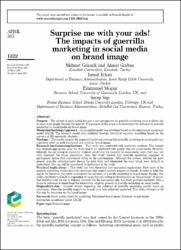Surprise me with your ads! The impacts of guerrilla marketing in social media on brand image
Abstract
this paper is to investigate the influence of guerrilla marketing in social media on brand image.
Design/methodology/approach - A conceptual model was developed based on the information acceptance model (IACM). The research model was validated through structural equation modelling based on the surveys of 385 university students.
Findings - The results support the proposed model and confirm that guerrilla marketing in social media has a positive effect on both functional and symbolic brand image.
Research limitations/implications - This study was conducted with university students. This sample was deemed appropriate since the study had to be conducted with people who use social media. However, although the age group of university students constitutes the majority of social media users, they may not fully represent the whole population. Also, this study showed four guerrilla marketing examples to participants before they commenced filling in the questionnaire. Although the authors selected the most generic guerrilla advertisements during the pilot tests and eliminated the ones which were difficult to understand, this can still be considered as limitations of the study.
Practical implications - This study has both theoretical and managerial implications. First, most of the guerrilla marketing studies focus on consumers and neglect possible impacts on brands. In order to fulfil this gap in the literature, this study investigates the influence of guerrilla marketing in brand image. Besides, this study contributes to IACM by expanding its scope through testing its determinants on "brand image". It proves that IACM is valid for use in different contexts. On the managerial side, this study provides marketers with a frame of reference to understand the information adoption process of guerrilla marketing on social media.
Originality/value - Current studies regarding the influence of guerrilla marketing mostly focus on consumers, where the possible impacts on brands have been relatively neglected. This study attempts to fill this gap by focussing on the brand image.


















